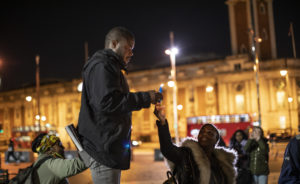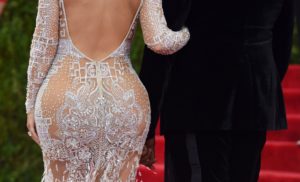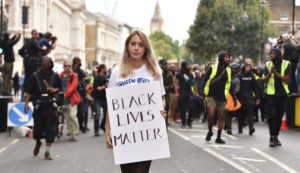Sweet Brown is wearing a tie-dyed tank top, a scarf knotted around her short dark hair. She’s talking to the camera like it’s someone she knows intimately, telling the story of her brush with death: “I said, oh lord Jesus, it’s a fire! Then I ran out, I didn’t grab no shoes or nothing. Jesus! I ran for my life!” And then she delivers the line that will make her famous: “Ain’t nobody got time for that!”
The interview went viral in 2012. And the final line, shortly after it was uttered, became culturally ubiquitous, particularly on social media where it proliferated as a reaction GIF — it was also, crucially, the subject of a fierce debate about whether its popularity was racist. Did we love Sweet Brown for her story and her screen presence, or was it because she was a walking, talking stereotype of the archetypal sassy black woman?
That debate has waxed, waned and evolved over the years, but the one thing it stubbornly refuses to do is die. Five years after Sweet Brown’s original interview, it was given new weight with the coining of a phrase. In a Teen Vogue essay, Lauren Michele Jackson described the act of non-black people using reaction GIFs featuring black Americans as “digital blackface”. And so, a trend was born: The New York Times weighed in, followed by The Guardian, followed by the mommy bloggers and the service journalists. Just when it seemed like the internet had squeezed the concept dry, it returned again, last weekend, in the form of a clickbaity banner on the front page of CNN: “What’s ‘digital blackface’? And why is it wrong when White people use it?”
For those who remember this argument in its original iteration, the immediate reaction is probably best encapsulated by a meme from the pre-social internet — not one of the ones that allegedly constitutes digital blackface, but the one from Mean Girls, in which an enraged Regina George hisses: “Stop trying to make ‘fetch’ happen! It’s not going to happen!” We do not need to do this again. This argument was transparent, racebaiting, outrage fodder even when it was new; now, it is all of that and tired.
If anything, the notion that, as CNN’s John Blake insists, employing reaction GIFs featuring black people represents “one of the most insidious forms of contemporary racism” is illustrative of just how badly the discourse is foundering in the wake of the massive racial reckoning sparked by the murder of George Floyd. All that momentum, all that money, all those marches and protests and pleas for real change end up being squandered again and again on luxury beliefs: galaxy-brained takes that circulate like wildfire among members of the coastal media class while being utterly bewildering to any normal person. The absurdity of Blake’s argument seems obvious even for those who think America is a long way from being a post-racial paradise. This is a country where black citizens remain underrepresented in key positions of power, and disproportionately suffer from poverty and violence. How terminally online must one be to think that the “most insidious” form of racism comes in the form of some 60-year-old Facebook grandma in Des Moines who feels that her emotions are best represented by a GIF of Stanley from The Office rolling his eyes?
But then, one gets the sense that no one does think this. Not even the people who are earning a living — or at least, a few hundred freelance dollars a pop — by arguing as much. Every writer who tackles this topic has dutifully attempted to connect the mimetic phenomenon of reaction GIFs to the atrocious (and happily defunct) practice of minstrel shows featuring performers in actual blackface. But given the integrated state of contemporary society, and the substantive difference between posting a video of a black cultural icon and doing a mocking impression of one yourself, that’s a tough argument to sell.
Often, those recycling it don’t even seem to be trying. Women’s Health claims that using the wrong reaction GIFs isn’t just upstream from minstrelsy, but also from murder: “[As] it has been proven throughout U.S. history, a Black man can be killed for demonstrating aggression, confusion, or even indifference. Popular GIFs of Kanye West looking serious, Nick Young with question marks around his face, and others, show Black men expressing themselves which, while technically be harmless [sic], can oftentimes be fatal.”
This isn’t just unpersuasive; it’s practically incoherent. Does anyone believe this argument? Does anyone even believe that the writer believed it? The whole enterprise feels so convictionless, more like a simulation of an opinion than the real thing.
If anything, the concept of “digital blackface” reads like an attempt to meme more racism into existence by claiming that it’s already everywhere. Like the too-credulous coverage of outrageous hate crimes that turn out to be hoaxes, stories about the hidden racism of reaction GIFs suggest the need for constant vigilance, which in turn fuels perpetual mistrust. The overarching narrative, as I wrote last year, is one of a deep and roiling river of racial conflict running beneath the surface of American society. The moral of the story is that we can only ever relate to each other through the lens of power, privilege, resentment, and loathing — that, as Robin DiAngelo instructs, there can be no question of racism’s presence in any given interaction, only of how the racism manifests.
It’s a pessimistic and profoundly superstitious mode of thinking — racism, the devil lurking in every room — and one that has spawned a particularly fervent adherence among millennial white women, for whom self-help and self-hatred have always been inextricably intertwined. Blake’s essay quotes a young woman named Elizabeth Halford who narrates her use of reaction GIFs with the ecstasy of the confessing sinner: “I’ve appropriated Black trauma as punchlines and peeled their faces off to put on my own and say what I can’t say, to make you laugh, or just because it went viral.”
It’s hard to imagine who or what is served by this confession, apart from Halford’s masochism. It is also hard to imagine that any GIF could represent a greater affront to black people than the idea that selecting said GIF is akin to peeling their faces off.
But more discouraging than the pessimism (and bizarre Hannibal Lecter comparisons) inherent to this worldview is its racism — and not the insidious, subtle kind. The original Teen Vogue essay introducing the concept of digital blackface bemoaned that “black reaction GIFs have become so widespread that they’ve practically become synonymous with just reaction GIFs”, as if the ubiquitous presence of black people in American culture is a bad thing.
Blake’s CNN piece calls out specific, seminal memes: an outraged Tyra Banks on America’s Next Top Model shouting, “I was rooting for you! We were all rooting for you!”, or Michael Jordan crying at his induction into the Basketball Hall of Fame. Maybe these are “black reaction GIFs”, in that they are reaction GIFs featuring black people. But surely what they capture is something bigger. These are American celebrities. This is American culture.
But lately, an impulse has found a regrettable level of validation in American media, academia, and cultural institutions — an impulse to fracture and resegregate society along racial lines. American colleges hold exclusive, separate graduation ceremonies that segregate students by racial background. Lizzo, a multiple Grammy winner and one of the most famous musicians in the country, is forced to defend herself against allegations that her music is too popular among white people. An influencer goes viral for urging white moviegoers to stay away from the new Black Panther movie. Media institutions fret over race-matching the authors of book, theatre, and film reviews to the content they’re critiquing.
All of this is great, of course, if you have an economic stake in keeping Americans at each other’s throats. But for the rest of us, it only fuels polarisation and mistrust. The most incisive response to the latest “digital blackface” article came from Wilfred Reilly, a professor of political science at the University of Kentucky, who tweeted: “This stupid article is important in only one way: it illustrates that, as actual racism continues to decline, new varieties will simply be invented/’promoted’ and used to make us fight one another.”
In a diverse, thriving, integrated society that includes people of multivariate backgrounds, of course non-black citizens are going to engage with, appreciate, and relate to cultural products created by their black countrymen — and vice versa. Not only could it not be otherwise — culture, in our highly mimetic species, has long proven itself impossible to contain — but isn’t it what we want? The popularity of these GIFs stems from the fact that they represent events, emotions, and cultural touch points that millions of people recognise and relate to; in many cases, they speak to something not just specifically American but deeply human. That something like the Crying Jordan meme has become a global visual shorthand for conveying our feelings — the fact that people of every age, shape, colour and creed feel represented by the raw emotion captured there — should be seen as a triumph of common humanity over identity category. It is, at the population level, exactly what an inclusive society should strive for.
In this context, it seems not just absurd but grotesque for our national news media to argue that we should wall off these memes from the American mainstream, or make it so fraught for non-black people to engage with them that it becomes effectively taboo. The idea that black culture, whether it’s memes or music or slang or style, needs to be kept separate for its own protection is indistinguishable in practice from the racist ghettoisation that once sidelined black artists and athletes from the mainstream, lest they pollute the spaces where white people gathered. At its root is the notion that black culture is not American culture, that black people are somehow other. And, well, you know, there’s a word (and a GIF) for that.
Disclaimer
Some of the posts we share are controversial and we do not necessarily agree with them in the whole extend. Sometimes we agree with the content or part of it but we do not agree with the narration or language. Nevertheless we find them somehow interesting, valuable and/or informative or we share them, because we strongly believe in freedom of speech, free press and journalism. We strongly encourage you to have a critical approach to all the content, do your own research and analysis to build your own opinion.
We would be glad to have your feedback.
Source: UnHerd Read the original article here: https://unherd.com/




